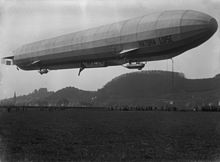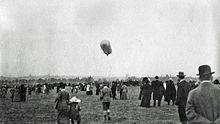LZ 11




The Zeppelin LZ 11 "Viktoria Luise" was a commercial airship owned by the Deutsche Luftschiffahrts-Aktiengesellschaft ( DELAG ) at the beginning of the 20th century. It was named after the Prussian princess Viktoria Luise .
history
The maiden voyage took place on February 14, 1912, and the first passenger voyage was undertaken on March 4. The ship had previously been transferred to Frankfurt in mid-February . The zeppelin "Viktoria Luise" mainly drove within Germany and to Helgoland , Hamburg and Copenhagen . With the outbreak of the First World War , LZ 11 had to be handed over to the German army and served there as a training ship. Previously, it had covered 54,312 kilometers on 489 passenger journeys and carried 9,738 people (including crew). On October 8, 1915, it was destroyed when it entered the airship port in Liegnitz . In total, the "Viktoria Luise" zeppelin made over 1400 trips.
Technical design
In terms of shape, construction and layout, the LZ 11 was a sister ship to LZ 10 “Schwaben”, which had proven itself in almost 150 accident-free trips for DELAG in the summer and autumn of 1911, but was destroyed in an accident in 1912 on the Düsseldorf airfield . The main difference between the LZ 11 and the “Schwaben” was a few small improvements, particularly to the controls, and the installation of a further eight meter long segment. The ship had a length of 148 m with a diameter of 14 m and a volume of 18,700 cubic meters. Inside the shell there were 18 individual gas cells filled with hydrogen , each embedded between two cross rings of the aluminum frame. In this way, the ship was still navigable even if one or more cells leaked .
The entire framework with the gas cells enclosed in it was covered with an impregnated cotton fabric in order to reduce the friction between the gas cells and the outer shell and to protect the cells from excessive heating from solar radiation.
Two machine gondolas were suspended in the middle below the supporting structure, with a passenger cabin between them. One of the three Maybach motors with an output of 110 kW (150 hp ) each and all control elements such as steering wheels, ballast and valve trains were located in the front gondola , as this gondola was also the driver's gondola. The other two engines were in the rear nacelle.
The front motor drove a pair of double-bladed propellers at around 500 revolutions per minute. At the rear end of the airship were in a frame side and elevators . The vertical tail consisted of six vertical surfaces. They enabled a turning circle of around 550 meters. In addition, at the end of the float there was a large horizontal fin on the left and right, the so-called stabilization surfaces . You should ensure that the ship flies smoothly.
The engines developed a total of around 330 kW and gave the airship a cruising speed of around 17 m / s (around 61 km / h) and a top speed with all three engines of around 21 m / s (72 km / h).
The load capacity was around 6500 kilograms, depending on the desired flight altitude. An airship of this size lost around 200 kg for every 80 m flight altitude and a further 75 kg of payload for every degree Celsius warming up in the air. 1200 to 1500 kilograms of the load capacity were usually used for the consumption of petrol and oil. LZ 11 thus had a travel time of 10 to 12 hours with all engines and 15 to 20 hours with two engines. During this time, the zeppelin was able to cover around 800 to 1000 kilometers in the air. The distance above the ground was dependent on the wind direction and speed. It could vary between 400 and 1500 kilometers.
The ship's crew consisted of eight to nine people: an airship pilot, a navigation engineer, two helmsmen and one or two fitters in the front gondola, the rest of the people in the rear gondola.
The passenger cabin hanging between the two machine gondolas and in the middle of the airship (designed and implemented by the Vereinigte Hof-Möbelfabriken Bauer and Wirth, Stuttgart) offered space for 20 people. It was built into the airship in such a way that the side members of the airship frame also supported the cabin. Furthermore, it was secured in its position twice with twelve steel wires. It had an adjoining room for kitchen supplies, which was provided with a bottle cabinet and sideboard . All metal parts of the cabin frame inside the cabin were clad with mahogany , as well as the panels and the ceiling were made of mahogany veneer . Inlay work in mother-of-pearl on the ceiling beams and pillars made the cabin appear extremely comfortable and elegant. There was also a toilet room with running water at the rear of the passenger cabin. The floor consisted of five-fold glued wood and was carpeted. Large top-hung windows allowed an unobstructed view on all sides. The seating consisted of wicker furniture . Cold food and drinks were available during the journey.
Sister ship of LZ 11 was LZ 13 "Hansa" , which from July 30, 1912 also carried out passenger trips for DELAG.
See also
Web links
Individual evidence
- ↑ a b c d e f g h Zeppelin-Weltfahrten , Heel Verlag, book no. 19484-5; 2000; Koenigswinter; (Reprint of a Zeppelin scrapbook from 1932) LZ 11 in the chapter on pre-war airships
- ↑ a b c d e Ludwig Dürr : Twenty-five years of Zeppelin airship construction. VDI-Verlag, Berlin 1924 page 30/31. - Reprinted in: Peter Kleinheins , Wolfgang Meighörner (eds.): The big zeppelins. The history of airship construction. Springer, Berlin, 3rd, revised edition 2005; ISBN 3-540-21170-5 ; Page 58/59
- ↑ earlyaeroplanes.com: Photo with caption from LZ 11 in Baden-Oos ( memento from March 4, 2016 in the Internet Archive ), accessed on February 5, 2017
- ^ Peter Meyer: Airships - The History of the German Zeppelins , Bernard & Graefe Verlag, Bonn 1996, ISBN 3-7637-5951-4
